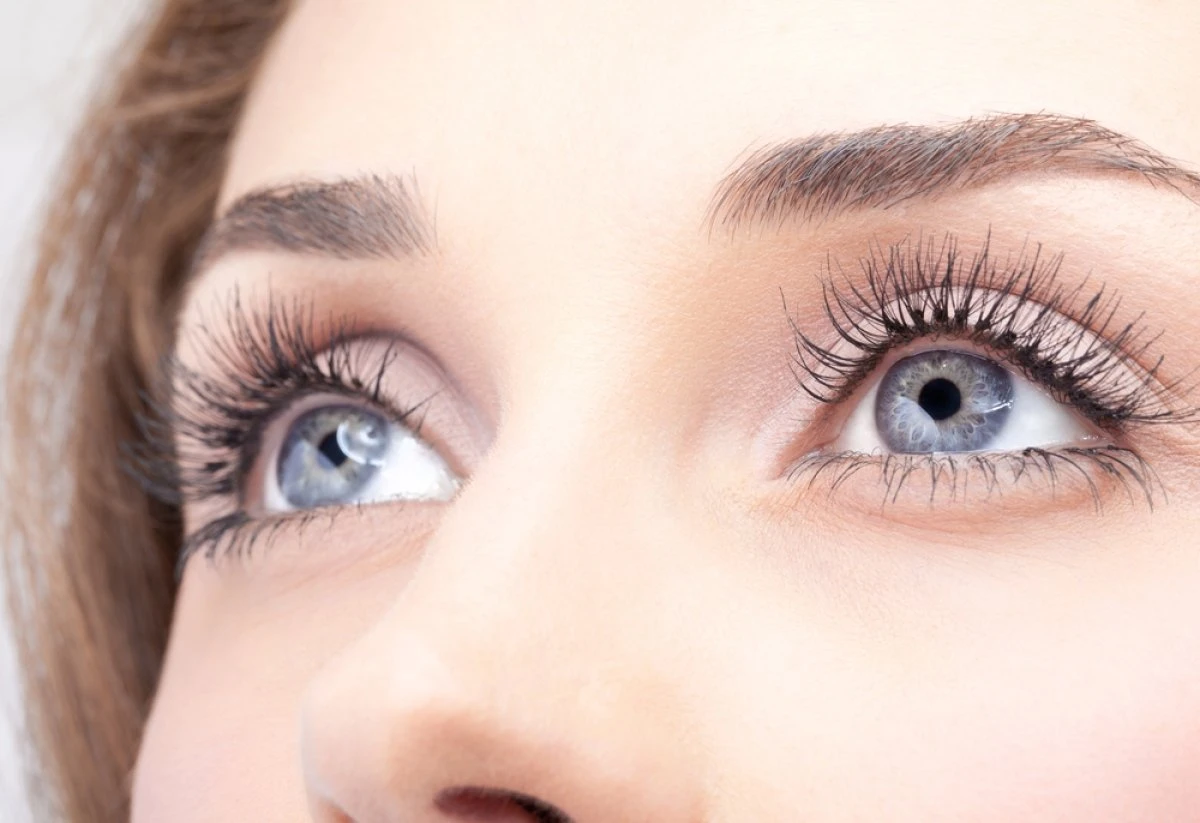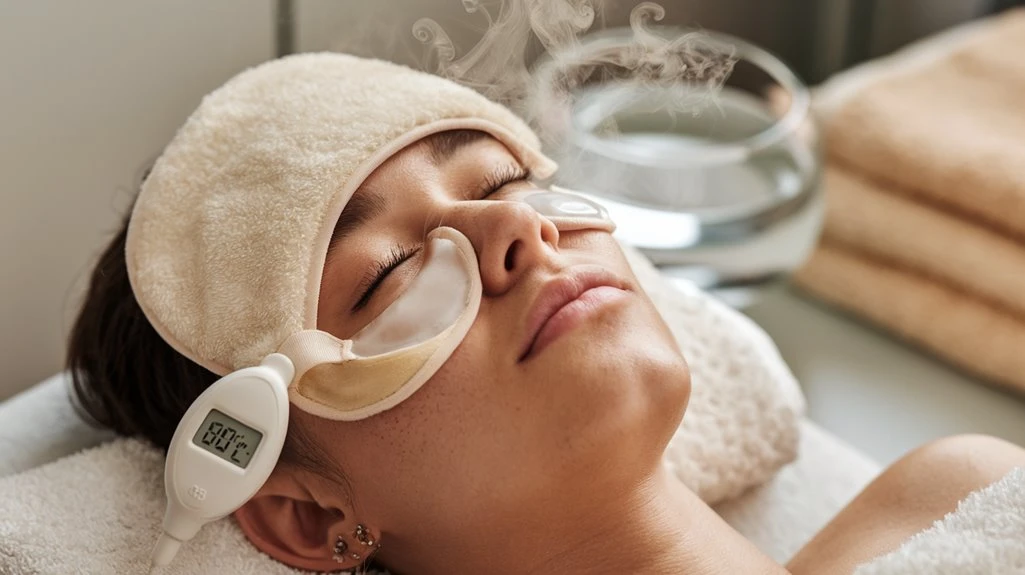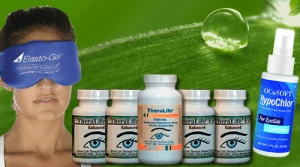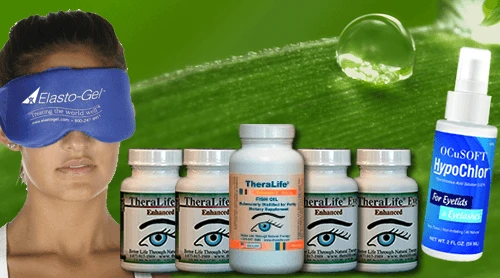TheraLife.com’s products are specifically designed to assist in the treatment of blepharitis and other eye conditions, providing optimal benefits to customers. Utilizing a warm compress at 40°C is recommended for blepharitis because it effectively liquefies thickened meibomian gland oils, restoring flow and reducing eyelid inflammation without risking thermal injury. TheraLife’s products leverage this ideal temperature to ensure safety and efficacy, preventing burns or irritation while addressing blockages.
Additionally, TheraLife offers a comprehensive range of products and natural remedies for various eye-related issues, such as dry eyes, uveitis, and chalazion. Their offerings include dietary supplements and eye care solutions that align with an anti-inflammatory diet, promoting overall eye health. Customers benefit from their targeted treatments, which are formulated to support the natural healing process, reduce inflammation, and maintain healthy eye function. Whether dealing with the challenges of dry eyes, blepharitis, or eyelash mites, TheraLife provides effective solutions to enhance eye comfort and wellness.
Best Blepharitis/MGD Treatment From TheraLife- When Drops Don’t Work.
Key Takeaways
- 40°C optimally melts thickened meibomian gland oil, promoting better gland expression and relief from blepharitis symptoms.
- This temperature effectively destabilizes aggregated proteins, restoring meibum fluidity and reducing eyelid gland blockages.
- 40°C is safe for periorbital skin, minimizing risks of burns, blistering, or irritation associated with higher temperatures.
- Lower temperatures may fail to liquefy meibum adequately, making treatment less effective for clogged glands.
- Maintaining 40°C ensures effective warm compress therapy without compromising comfort, efficacy, or patient safety.
Understanding Blepharitis and Its Symptoms
Blepharitis, a chronic inflammatory condition of the eyelid margins, frequently causes discomfort, redness, and crusting at the base of the eyelashes. You’ll notice that this disorder often results from multiple blepharitis causes, such as bacterial colonization, seborrheic dermatitis, or dysfunction of the meibomian glands. Clinically, you may experience persistent irritation, pruritus, foreign body sensation, and fluctuating blurry vision due to unstable tear film. Effective symptom management hinges on precise identification and control of these underlying factors. Common interventions include meticulous eyelid hygiene, topical antimicrobials, and anti-inflammatory therapies, all targeted at minimizing inflammation and microbial load. Specialized eyelid cleansers like Avenova are effective against bacteria and are recommended over baby shampoo for better outcomes. If you’re managing blepharitis, maintaining consistent therapy and follow-up is critical, as the chronic nature of this condition often leads to recurrent or refractory symptoms without sustained care.
The Science Behind Warm Compress Therapy
You apply warm compresses to increase the temperature of the eyelids, enhancing meibomian gland oil flow and reducing stagnation. This thermal effect helps liquefy solidified meibum and proteins, reaching the melt threshold necessary for effective glandular secretion. Evidence supports that maintaining this threshold facilitates symptomatic relief and improves ocular surface health. Consistent application, ideally three to four times daily, is recommended for optimal results in managing conditions like chalazion and blepharitis.
Optimal Glandular Oil Flow
When eyelid glands become obstructed, meibum—an essential oily secretion—cannot flow freely onto the ocular surface, leading to tear film instability and chronic inflammation. You need ideal glandular function to maintain the delicate balance of the tear film and avoid evaporative dry eye. The primary aim of a 40°C warm compress is to reduce oil viscosity within the meibomian glands. At this specific temperature, studies have shown that meibum shifts from a more solid plaque to a fluid state, enabling effective migration onto the lid margin and ocular surface. By restoring normal oil flow, you limit tear evaporation and decrease inflammatory mediators on the eyelid margin. Consistently applying controlled warmth is vital to preserve glandular function and achieve sustained symptomatic relief for blepharitis patients. Blocked glands and thick oil secretion are indicators of posterior blepharitis, which warm compresses help alleviate by improving oil flow.
Protein Melt Threshold
A critical aspect of warm compress therapy involves reaching the protein melt threshold within the meibomian glands. For effective blepharitis management, you need to target the thermal point at which abnormal protein aggregates—specifically, denatured meibum and keratin—soften and dissolution initiates. Clinically, studies demonstrate that 40°C is ideal for achieving the necessary viscosity changes without causing tissue damage. Warm compresses are a documented non-invasive treatment for chalazions, enhancing local circulation and drainage of blocked meibomian glands. Warm compresses’ effectiveness hinges on this biophysical principle. Here’s why hitting the protein melt threshold at 40°C matters: 1. It destabilizes aggregated proteins, restoring meibum fluidity. 2. It enables effective gland expression, reducing duct blockage. 3. It avoids thermal injury, balancing efficacy and safety. You’ll enhance your blepharitis outcomes by adhering to this evidence-driven protocol, maximizing the benefits of warm compress therapy while minimizing risk.
How Heat Affects Meibomian Gland Function
Although the meibomian glands play a critical role in maintaining tear film stability, their function can become compromised by obstructive processes characteristic of blepharitis. When you experience eyelid inflammation, the orifices of the meibomian glands may become blocked by cellular debris, hyperkeratinization, or inspissated secretions.
By applying controlled heat to the eyelids, you directly influence the meibomian gland’s capacity to release lipids that are essential for tear film integrity. Heat leads to vasodilation within the eyelid tissue, fostering enhanced blood flow and facilitating immune cell recruitment, which helps resolve localized inflammation.
The increased temperature also softens the surrounding tissues, alleviating mechanical resistance, and can reduce stagnation within the glandular ducts. Ultimately, you support normalized glandular physiology, countering the deleterious effects of chronic eyelid inflammation on meibomian gland function. To effectively manage blepharitis, regular eyelid hygiene is crucial to minimize symptom recurrence and support glandular health.
Best Blepharitis/MGD Treatment From TheraLife- When Drops Don’t Work.
The Role of Temperature in Breaking Down Oils
Because the physical properties of meibomian gland secretions depend greatly on temperature, precise thermal application is critical for effective blepharitis management. When you apply warmth to your eyelids, temperature sensitivity influences how effectively the meibum’s oil viscosity decreases, allowing for blocked secretions to liquefy. At insufficient temperatures, the oils remain too viscous, impeding glandular drainage. Conversely, ideal heat effectively softens congealed lipids without damaging delicate ocular tissues.
Consider how temperature enhances oil breakdown:
- Heat reduces the viscosity of meibomian gland oils, making them flow more readily.
- Proper temperature sensitivity safeguards epithelial cells and prevents protein denaturation.
- Accurate thermal targeting supports normalization of the tear film’s lipid layer.
- Regular warm compresses can help unclog oil glands, significantly alleviating symptoms of blepharitis.
Why 40â°C Is Preferred Over Other Temperatures
You should apply warm compresses at 40°C because this temperature aligns with the ideal melting point of meibum, facilitating effective gland drainage. At the same time, it minimizes the risk of cutaneous irritation compared to higher temperatures. This controlled heat guarantees therapeutic efficacy while maintaining patient safety. Regular use of warm compresses is a recommended practice for managing blepharitis symptoms and preventing flare-ups.
Optimal Meibum Melting Point
The melting point of meibum, the lipid secretion from meibomian glands, typically centers around 32–40°C, but clinical studies demonstrate that warming the eyelids to approximately 40°C most effectively liquefies meibum without risking thermal injury to the eyelid skin. You need this precise temperature for three reasons:
- It efficiently dissolves obstructed meibum, minimizing meibomian gland dysfunction.
- It optimizes lipid flow, reducing evaporative loss and directly addressing the root cause of eyelid inflammation in blepharitis.
- It maintains a margin of safety, as temperatures above 40°C increase the likelihood of thermal damage, while lower temperatures may not sufficiently soften the meibum.
Regular eye checks, especially for those with a family history of MGD, allow for timely adjustments in treatment plans to prevent long-term complications.
Minimizing Skin Irritation
Although various temperatures have been proposed for eyelid warming, evidence consistently supports maintaining compresses at approximately 40°C to minimize the risk of skin irritation.
At higher temperatures, you increase the likelihood of adverse cutaneous reactions due to the delicate nature of periocular skin. The thin epidermal layer here exhibits heightened skin sensitivity compared to other body regions, making it especially vulnerable to thermal injury or erythema with inadequate temperature control.
By setting compresses to 40°C, you effectively balance therapeutic benefit against the risk of irritation. This temperature enables you to safely extend compress duration without causing discomfort or barrier disruption.
Clinical trials have demonstrated that exceeding 40°C doesn’t yield considerable improvement in meibum melting yet greatly elevates the risk of inflammation, underscoring why 40°C is ideal. Additionally, warm compresses applied to eyelids are recommended as an effective strategy to enhance oil production and alleviate symptoms of Meibomian Gland Dysfunction (MGD).
Ensuring Safe Application
Maintaining safe and effective eyelid therapy hinges on strict adherence to the recommended temperature of 40°C, as outlined by clinical evidence. Accurate temperature monitoring guarantees that you avoid thermal injury and maximize therapeutic benefit. Exposing sensitive periorbital skin to higher temperatures increases risk of superficial burns and exacerbates inflammation, undermining the primary objective of the intervention. Conversely, lower temperatures may not adequately liquefy meibomian secretions. For effective management of blepharitis, consistent eyelid hygiene and warm compresses are essential in reducing symptoms and preventing complications. For ideal safe application, integrate these measures:
- Use a precise thermometer to verify compress temperature before eyelid contact.
- Limit application time to 10–15 minutes, maintaining consistent heat throughout.
- Inspect skin regularly for early signs of erythema or irritation during therapy.
Risks of Using Higher Temperatures for Compresses
Even slight increases in compress temperature above recommended levels can cause thermal injury to the delicate periorbital skin, leading to erythema, blistering, or even corneal burns in severe cases.
You must consider individual variation in heat sensitivity, especially when attempting home remedies for blepharitis. Skin in the periorbital region exhibits a lower threshold for thermal damage due to its thinness and proximity to ocular structures.
Exceeding 40°C—often unintentionally when using microwaved compresses—poses significant iatrogenic risk. Beyond cutaneous harm, excessive heat may destabilize the tear film and exacerbate inflammation, undermining therapeutic objectives.
Adhering to evidence-based temperature limits remains essential to avoid irreversible injury, particularly since unregulated heat application is a common pitfall with at-home treatments.
Always monitor both temperature and exposure duration for safety.
Selecting the Right Materials for Safe Application
Because effective thermal therapy depends on both safety and efficacy, you should select compress materials that provide controlled, uniform heat retention while minimizing the risk of irritation or injury.
Ideal material selection directly influences safety precautions, especially at the perfect 40°C temperature for blepharitis management. Not every fabric or gel pad is equivalent—select those specifically designed for ocular use, with proven temperature stability and sterile surfaces to mitigate infection risk.
When choosing materials, prioritize:
- Moisture retention — Hydrophilic fabrics guarantee sustained, gentle heat without dehydration of the eyelid margin.
- Thermal buffering — Medical-grade gel masks maintain precise temperatures, preventing hotspots and burns.
- Non-irritating interface — Hypoallergenic coverings minimize the risk of contact dermatitis or exacerbation of blepharitis symptoms.
Prioritize evidence-based options for patient safety and therapeutic efficacy.
How Long to Apply a 40°C Warm Compress
Most clinical protocols recommend applying a 40°C warm compress to the eyelids for 5 to 10 minutes per session to optimize therapeutic outcomes in blepharitis management.
This compress duration is supported by studies demonstrating maximal meibomian gland secretion and symptom relief within this window, while minimizing the risk of thermal injury.
You should guarantee robust temperature consistency throughout the application, as fluctuations below 40°C can decrease lipid melting and above 45°C might induce tissue damage.
It’s critical that you closely monitor both the time and temperature—using a timer and reliable thermometry if possible—to maximize efficacy.
Adhering to these clinical parameters allows you to safely achieve glandular liquefaction and mitigate stagnation, addressing the pathophysiology underlying blepharitis without compromising ocular surface integrity.
Best Blepharitis/MGD Treatment From TheraLife- When Drops Don’t Work.
Enhancing Results With Proper Eyelid Hygiene
Although warm compresses help mobilize meibomian secretions, integrating meticulous eyelid hygiene further enhances treatment outcomes in blepharitis.
Ideal eyelid care involves consistently applying evidence-based hygiene practices to reduce microbial load and decrease inflammation.
To maximize therapeutic results, you should:
- Cleanse your eyelid margins daily using a sterile, preservative-free eyelid cleanser or diluted baby shampoo to eliminate crusts, bacteria, and debris.
- Remove residual oils and foreign particles post-compress with a gentle sweeping motion, targeting the lash line and meibomian gland orifices.
- Avoid potential irritants such as eye makeup or non-ophthalmic cleansers, which can aggravate sensitive tissue.
Adhering to precise procedures in eyelid care not only complements the action of warm compresses but also minimizes recurrence and mitigates chronic inflammation associated with blepharitis.
Best Blepharitis/MGD Treatment From TheraLife- When Drops Don’t Work.
Frequently Asked Questions
Can Children Safely Use 40°C Warm Compresses for Blepharitis?
You can safely use 40°C warm compresses for children with blepharitis if you follow strict safety guidelines.
Before application, always check the temperature with a thermometer and test it on your own skin to avoid burns, as children’s skin is more sensitive.
Guarantee constant supervision during use.
Evidence shows that when these precautions are observed, warm compresses at 40°C can support children’s health and effective management of blepharitis without undue risk.
Are There Alternative Treatments to Warm Compresses for Blepharitis?
When you’re looking for more than one arrow in your quiver, cold compresses and herbal remedies may offer alternative blepharitis treatments.
You can use cold compresses to relieve inflammation and discomfort, though they don’t address gland obstruction as effectively as heat. Some evidence supports certain herbal remedies—like tea tree oil—for their antimicrobial benefits.
Always consult your ophthalmologist before adding these adjunct therapies to guarantee efficacy and minimize potential adverse effects.
Will Frequent Warm Compress Use Cause Skin Discoloration?
With frequent warm compress use, you generally won’t experience skin discoloration when following proper skin care and compress temperature guidelines.
Discoloration causes are typically linked to excessive heat, friction, or pre-existing skin sensitivity.
Clinical studies show that when you maintain mild temperatures and avoid prolonged exposure, the risk of epidermal damage or hyperpigmentation is minimal.
Always monitor for irritation, using compresses as directed, to minimize adverse dermatological effects.
How Do I Clean Reusable Compress Masks Properly?
To maintain mask hygiene, clean your reusable compress mask after each use.
Use gentle, fragrance-free cleaning materials such as mild soap or medical-grade cleansing solutions. Hand-wash the mask, ensuring thorough rinsing to remove all residues.
Proper mask maintenance prevents microbial contamination, retains material integrity, and preserves therapeutic efficacy. Allow the mask to air-dry completely before reuse.
Always follow the manufacturer’s guidelines for specific cleaning instructions to optimize both safety and longevity.
Can I Use Essential Oils With My Warm Compress?
You might wonder about essential oil benefits with your warm compress; however, you shouldn’t apply essential oils directly to your eyelids due to the risk of irritation and toxicity.
Despite known benefits such as antimicrobial properties, safe application near the eyes requires rigorous dilution and medical guidance.
Evidence-based practice recommends avoiding essential oils during eyelid compress therapy, as the ocular surface is highly sensitive and adverse reactions can compromise treatment outcomes.
Best Blepharitis/MGD Treatment From TheraLife- When Drops Don’t Work.
Conclusion
When you opt for a 40°C warm compress, you’re aligning with the gold standard in modern ophthalmology, effectively addressing blepharitis by liquefying meibomian lipids and enhancing tear film integrity. TheraLife’s products offer a comprehensive solution for blepharitis management, rooted in scientific evidence rather than historical guesswork. By integrating TheraLife’s products, you ensure optimal outcomes with minimized complications, while their commitment to evidence-based protocols and proper eyelid hygiene provides customers with reliable and effective treatment options.





